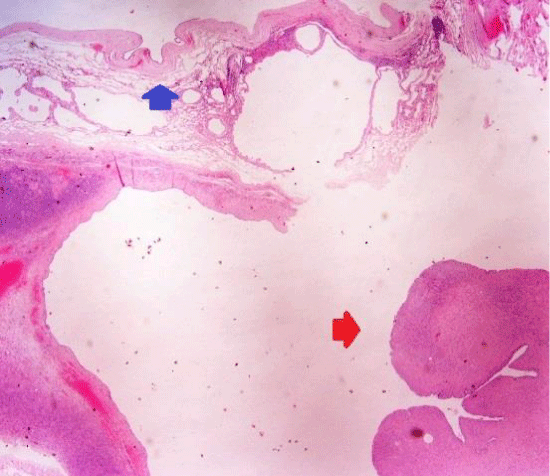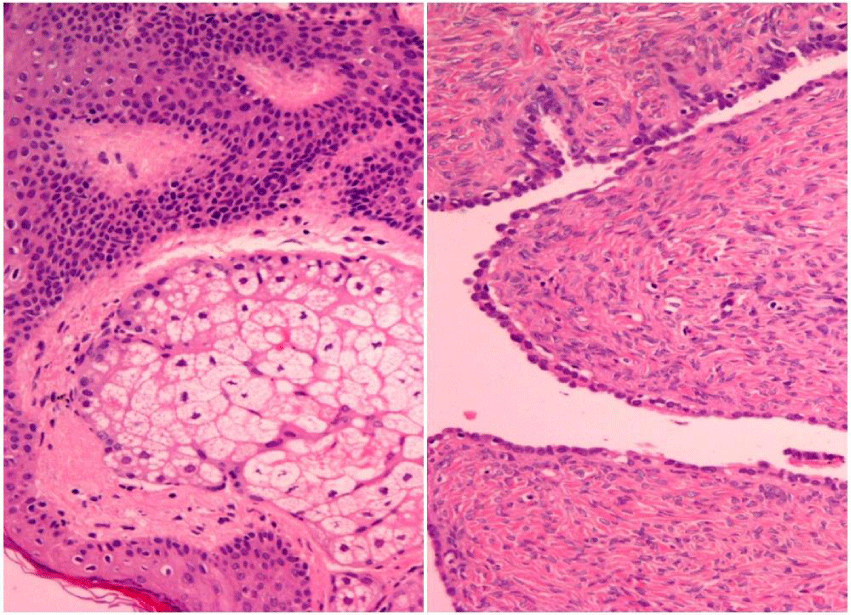Journal of Surgery and Surgical Research
Collision Tumor of the Ovary. Adjunction Cystic Teratoma and Serous Cystic Adenofibroma. Presentation of a Rare Case
Sofoudis C1*, Louis K1, Papamargaritis E1, Lenos M2 and Gerolymatos A1
2Department of Surgical Pathology, Konstanopoulio General Hospital, Athens, Greece
Cite this as
Sofoudis C, Louis K, Papamargaritis E, Lenos M, Gerolymatos A (2018) Collision Tumor of the Ovary. Adjunction Cystic Teratoma and Serous Cystic Adenofibroma. Presentation of a Rare Case. J Surg Surgical Res 4(1): 007-009. DOI: 10.17352/2455-2968.000051Ovarian cystic teratomas consist of germ cell tumors. They appear in female patients aged 20-40 years, comprising 15% of all ovarian neoplasms. These tumors appear in 90% of cases unilateral. Benign serous cyst-adenofibromas represent the most common ovarian epithelial tumor, with an incidence of 42%, accounting 83% of serous ovarian tumors. The mean diameter estimates among 5 and 35 cm, with a bilateral incidence of 35%. A collision tumor is composed of two adjacent, histological distinct neoplasms without the histological intermixture of cell types in the same organ or tissue. According to current bibliography, these tumor types can be depicted in various organs including esophagus, stomach, liver, lung, thyroid, and kidney and of course ovary. There are few reported cases describing the ovarian type. The objective of our study reflects the depiction of a rare collision ovarian tumor properly diagnosed and treated. The therapeutic mapping is strongly accompanied with the age and the fertility preservation of the patient.
Introduction
According to current literature, the histopathologic origin of collision tumors remains a controversial issue. The ovarian type consists a subgrup of all collision tumors, representing a rare entity with at least two tumors adjacent but histological distinct, without admixture, in the same tissue or organ [1]. The therapeutic mapping is strongly correlated with the histologic components, focusing on the fertility preservation and the quality of life of the patient. There a few cases in the current bibliography depicting a collision tumor of the ovary as adjustment of cystic teratoma and serous cystic adenofibroma. Ovarian teratomas are co-existent with mucinous ystadenomas (4 cases), borderline mucinous tumors (1 case), mucinous cystadenocarcinomas (1 case) and dysgerminomas (1 case) [2]. Though cystic mature cystic teratoma consists of all three germ cell layers, it rarely presents with ovarian epithelial or sex cord stromal tumors. Collision tumors can be described in many anatomic organs such as esophagus, colon, appendix, liver, and kidney. Brahmania et al. reported a case of collision tumor located at the anatomic area of colon. (Adjunction of a colonic adenocarcinoma and an arising ovarian germ cell tumor) [3]. Dellaportas et al. reported a case of collision tumor located at the anatomic area of appendix (Adjunction mucinous cystadenoma and carcinoid) [4]. Each component of collision tumors occur coincidentally with no connection, and the biologic behavior depends on their own tumor characteristics. All these rare reported cases are focusing on two basic categories. Not only the theoretic explanation concerning the pathogenesis of such tumors, but also the therapeutic mapping. Predisposing factors such as tumor size, age of the patient, fertility status, presence of lymphatic infiltration, staging of the lesion, can influence the therapeutic strategy. Ultimate goal remains the fertility preservation and the quality of life of the patient.
Case
We present a case of a 69 year Caucasian female patient (para 1,gravida 1), with free atomic history admitted to our Department complaining about pelvic pain and presence of palpable mass inside the peritoneal cavity. The physical examination revealed enlarged uterus with sensitivity in the area of left iliac region. The ultrasound report confirmed the results of the physical examination, revealing a cystic formation in the anatomic area of left adnexa maximal diameter 6, 4X4, 4X3, 2cm. In the area of right adnexa a cystic formation measuring 2cm without malignant characteristics was depicted. Pap smear without signs of pathology. Tumor markers, including Ca 125 and Ca 19, 9 in normal ranges, decreasing the possibility of malignancy. All peritoneal organs revealed no signs of pathology. Patient underwent left salpigo-oophorectomy and dissection of the right cystic adnexal formation. The cytologic examination of peritoneal cavity fluid did not show elements of malignancy. Frozen section of the left adnexa did not reveal malignant formations.
The histologic examination revealed the adjustment of cystic teratoma and serous cystic adenofibroma inside the left ovarian cavity (Figures 1a,b). The histopathologic formation of these two benign tumors without the cellular intermixture in the same anatomic organ called collision ovarian tumor. After a short period the patient discharged from the hospital in a good clinical condition. The annual follow up with annual Pap smear and transvaginal ultrasound examinations depicted all peritoneal organs, including right adnexa, with normal morphology and anatomic function.
Discussion
According to current literature, the embryologic origin of ovarian tumors consists of surface epithelial stromal tumors, sex cord - stromal tumors and germ cell tumors. The incidence of germ cell tumors estimates 20 to 40% of ovarian tumors. On the other side, surface epithelial stromal tumors are classified as serous mucinous, endometrioed clear cell, transitional cell tumors [5,6]. The classification of serous tumors can be divided into benign cyst, adenoma borderline or malignant formation. Many conducted studies revealed the correlation between benign and malignant serous ovarian tumors. Every five cases of serous ovarian neoplasms appeared as benign, one appeared as malignant. Collision tumors reported in several organs including the esophagus, stomach, liver, lung, thyroid, kidney and of course ovary [7,8]. The adjunction of ovarian collision tumor reflects the combination of teratoma with mucinous tumors [9,10]. Such cases, in the current bibliography are rarely reported. There also examples of collision tumors consisting of teratomas with serous cyst adenocarcinomas, mucinous cyst-adenocarcinomas, granulose borderline cell tumors, mucinous tumors and disgerminomas [10]. Many theories have been conducted, concerning the pathogenesis of collision tumors. First, the hypothetic combination of two primary tumors in same tissue under the name “chance accidental meeting”. The second theory, suggests the formation of second primary tumor as reflection of creation of microenvironmental changes in first primary ovarian tumor tissue. The third theory concludes the common stem cell origin between primary ovarian tumors [11]. The gold standard, concerning the proper histopathologic diagnosis of a collision tumor consists of revelation of normal tissue among the two tumors without signs of admixture. The differential diagnosis between collision tumor and true mixed tumor can be more difficult with appearance of transitional zone between the tumors [12].
Conclusion
Many further studies must be conducted, in order to establish the incidence and the proper therapeutic mapping concerning the management of collision ovarian tumors. The adjustment among cystic teratomas and serous cystic adenofibroma inside the ovarian cavity remains a controversial issue. According the current bibliography the incidence of these tumors remains rare. Ultimate goal between general surgeons, gynecologists and histopathologists consists the fertility preservation and the quality of life of the patient.
Conflict of Interest
All authors declare any financial support concerning the following manuscript.
Written consent by the patient is performed concerning the publication of the following manuscript.
- Bige O, Demir A, Koyuncuoglu M, Secil M, Ulukus C, et al. (2009) Collision tumor: serous cystadenocarcinoma and dermoid cyst in the same ovary. Arch Gynecol Obstet 279: 767-770. Link: https://goo.gl/Ks6L6k
- Papaziogas B, Souparis A, Grigoriou M, Tsiaousis P, Kogia E, et al. (2008) A rare triple coexistence of a collision tumor, a benign mature cystic teratoma and a hemmorrhagic follicular cyst of the ovaries. Internet J Surg 14: 19–24.
- Brahmania M, Kanthan CS, Kanthan R (2007) Collision tumor of the colon. Colonic adenocarcinoma and ovarian granulosa cell tumor. World J Surg Oncol 5: 118. Link: https://goo.gl/jvNjQP
- Dellaportas D, Vlahos N, Polymeneas G, Gkiokas G, Damastani C, et al. (2014) Collision tumor of the appendix. Mucinous cystadenoma and carcinoid. A case report. Chirurgia 109: 843-845. Link: https://goo.gl/v3YBZ6
- Mukherjee S, Pal M, Mukhopadhyay S, Das I, Hazra R, et al. (2017) VEGF Expression to Support Targeted Therapy in Ovarian Surface Epithelial Neoplasms. J Clin Diagn Res 11: EC43-EC46. Link: https://goo.gl/Vn7pQC
- Al-Fozan H, Glassman J, Caspi B, Appelman Z, Tulandi T (2003) Lateral distribution of ovarian dermoid cyst. J Am Assoc Gynecol Laparosc 10: 489-490. Link: https://goo.gl/G3uGgj
- Choi GH, Ann SY, Lee SI, Kim SB, Song IH (2016) Collision tumor of hepatocellular carcinoma and neuroendocrine carcinoma involving the liver: Case report and review of the literature. World J Gastroenterol 22: 9229-9234. Link: https://goo.gl/KZG2Xq
- Naka T, Hatanaka Y, Marukawa K, Okada H, Hatanaka KC, et al. (2016) Comparative genetic analysis of a rare synchronous collision tumor composed of malignant pleural mesothelioma and primary pulmonary adenocarcinoma. Diagn Pathol 11: 38. Link: https://goo.gl/zfnfHr
- Roy S, Mukhopadhayay S, Gupta M, Chandramohan A (2016) Mature Cystic Teratoma with Co-existent Mucinous Cystadenocarcinoma in the same Ovary-A Diagnostic Dilemma. J Clin Diagn Res 10: ED11-ED13. Link: https://goo.gl/gjxwba
- McKenney JK, Soslow RA, Longacre TA (2008) Ovarian mature teratomas with mucinous epithelial neoplasms: morphologic heterogeneity and association with pseudomyxoma peritonei. Am J Surg Pathol 32: 645-655. Link: https://goo.gl/Qwu61Q
- Austin DC, Wu JS, Spentzos D, Goldsmith JD, Anderson ME (2017) A Collision Tumor Involving a Primary Leiomyosarcoma of the Lower Extremity and a Metastatic Medullary Thyroid Carcinoma: A Case Report. JBJS Case Connect 7: e90. Link: https://goo.gl/YsHv4n
- Sadow PM, Hunt JL (2010) Mixed Medullary-follicular-derived carcinomas of the thyroid gland. Adv Anat Pathol 17: 282-285. Link: https://goo.gl/3eXjz8
Article Alerts
Subscribe to our articles alerts and stay tuned.
 This work is licensed under a Creative Commons Attribution 4.0 International License.
This work is licensed under a Creative Commons Attribution 4.0 International License.



 Save to Mendeley
Save to Mendeley
